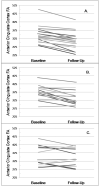One-year change in anterior cingulate cortex white matter microstructure: relationship with late-life depression outcomes
- PMID: 20808126
- PMCID: PMC3000437
- DOI: 10.1097/JGP.0b013e3181e70cec
One-year change in anterior cingulate cortex white matter microstructure: relationship with late-life depression outcomes
Abstract
Objective: differences in white matter structure measured with diffusion tensor imaging (DTI) are associated with late-life depression, but results examining how these differences relate to antidepressant remission are mixed. To better describe these relationships, the authors examined how 1-year change in DTI measures are related to 1-year course of depression.
Design: one-year cross-sectional follow-up to a 12-week clinical trial of sertraline.
Setting: outpatients at an academic medical center.
Participants: twenty-nine depressed and 20 never-depressed elderly subjects. Over the 1-year period, 16 depressed subjects achieved and maintained remission, whereas 13 did not.
Measurements: one-year change in fractional anisotropy (FA) and diffusivity in frontal white matter, as measured by DTI.
Results: contrary to our hypotheses, depressed subjects who did not remit over the study interval exhibited significantly less change in anterior cingulate cortex (ACC) white matter FA than did never-depressed or depressed-remitted subjects. There were no group differences in other frontal or central white matter regions. Moreover, there was a significant positive relationship between change in Montgomery-Asberg Depression Rating Scale (MADRS) and change in ACC FA, wherein greater interval decline in FA was associated with greater interval decline in MADRS.
Conclusion: older depressed individuals who remit exhibit white matter changes comparable with what is observed in never-depressed individuals, whereas nonremitters exhibit significantly less change in ACC FA. Such a finding may be related to either antidepressant effects on brain structure or the effects of chronic stress on brain structure. Further work is needed to better understand this relationship.
2011 American Association for Geriatric Psychiatry.
Figures


References
-
- Mitchell AJ, Subramaniam H. Prognosis of depression in old age compared to middle age: a systematic review of comparative studies. Am J Psychiatry. 2005;162:1588–1601. - PubMed
-
- Taylor WD, Steffens DC, MacFall JR, et al. White matter hyperintensity progression and late-life depression outcomes. Arch Gen Psychiatry. 2003;60:1090–1096. - PubMed
-
- Sullivan EV, Adalsteinsson E, Hedehus M, et al. Equivalent disruption of regional white matter microstructure in ageing healthy men and women. Neuroreport. 2001;12:99–104. - PubMed
-
- Pfefferbaum A, Adalsteinsson E, Sullivan EV. Frontal circuitry degredation marks healthy adult aging: Evidence from diffusion tensor imaging. Neuroimage. 2005;26:891–899. - PubMed
Publication types
MeSH terms
Substances
Grants and funding
LinkOut - more resources
Full Text Sources
Medical

